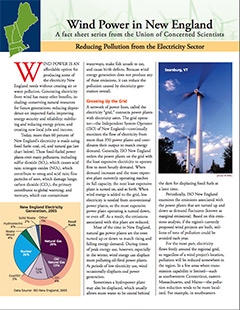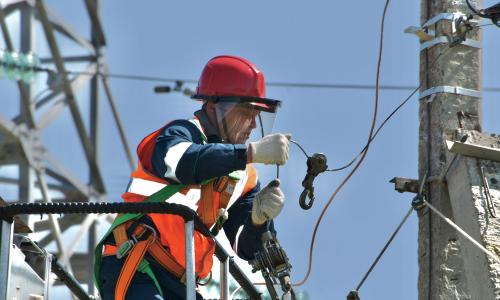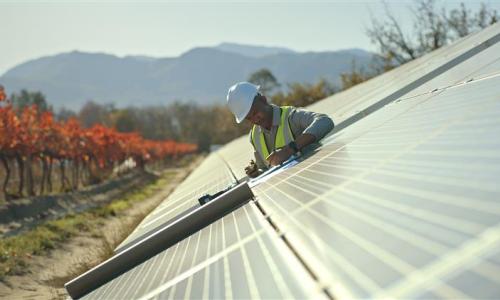Wind power is an affordable option for producing some of the electricity New England needs without creating air or water pollution. Generating electricity from wind has many other benefits, including: conserving natural resources for future generations; reducing dependence on imported fuels; improving energy security and reliability; stabilizing and reducing energy prices; and creating new local jobs and income.
Today, more than 60 percent of New England’s electricity is made using fossil fuels: coal, oil, and natural gas (see chart below). These fossil-fueled power plants emit many pollutants, including sulfur dioxide (SO2), which causes acid rain; nitrogen oxides (NOX), which contribute to smog and acid rain; fine particles of soot, which damage lungs; carbon dioxide (CO2), the primary contributor to global warming; and mercury, which can contaminate waterways, make fish unsafe to eat, and cause birth defects. Because wind energy generation does not produce any of these emissions, it can reduce the pollution caused by electricity generation overall.
Greening up the grid
A network of power lines, called the electricity “grid,” connects power plants with electricity users. The grid operator— the Independent System Operator (ISO) of New England—continually monitors the flow of electricity from more than 350 power plants and coordinates their output to match energy demand. Generally, ISO New England orders the power plants on the grid with the least expensive electricity to operate first to meet hourly demand. When demand increases and the most expensive plant currently operating reaches its full capacity, the next least expensive plant is turned on, and so forth. When wind energy is added to the grid, less electricity is needed from conventional power plants, so the most expensive power plant operating is turned down, or even off. As a result, the emissions associated with this plant are reduced.
Most of the time in New England, natural gas power plants are the ones turned up or down to match rising and falling energy demand. During times of peak energy use, however, especially in the winter, wind energy can displace more polluting oil-fired power plants. At periods of low electricity use, wind occasionally displaces coal power generation.
Sometimes a hydropower plant may also be displaced, which usually allows more water to be stored behind the dam for displacing fossil fuels at a later time.
Periodically, ISO New England examines the emissions associated with the power plants that are turned up and down as demand fluctuates (known as marginal emissions). Based on this emissions analysis,[1] if the region’s currently proposed wind projects are built, millions of tons of pollution could be avoided each year.
For the most part, electricity flows freely around the regional grid, so regardless of a wind project’s location, pollution will be reduced somewhere in the region. In a few areas where transmission capability is limited—such as southwestern Connecticut, eastern Massachusetts, and Maine—the pollution reduction tends to be more localized. For example, in southeastern Massachusetts, about 36 percent of the power generating capacity is oil-fired,[2] and at times it is difficult to transmit power out of the region. As a result, wind turbines built in that area are more likely to displace local oil-fired power plants, directly improving local air quality.
The importance of siting
In much of the nation, wind energy is one of the least expensive new renewable energy options available. New England is fortunate to have many windy sites, primarily on mountain ridges and along the coast. When deciding where to build a wind project, even small differences in wind speed make a big difference in the amount and cost of electricity produced. For example, a site with an average wind speed of 16 miles per hour (mph) can produce 30 percent more electricity than a site with 14 mph winds, and 50 to 60 percent more than a site with 13 mph winds,[3] which also means up to 60 percent more pollution is avoided per turbine.
Another factor in siting wind turbines is access to power transmission lines. If the site is located in a remote area, it can be costly to build new transmission lines to deliver the electricity from the wind turbine to customers.[4] As wind projects proceed to the development and permitting phase, studies are generally conducted to determine the impact the project would have on the local environment, including wildlife habitat and land use. Finding and supporting sites that have good wind speeds, are not prohibitively expensive, and meet permitting standards can help bring clean power and its associated pollution reductions to the region even sooner.
Pollution reduction policies
A number of regulatory and legislative strategies are available to help reduce pollution from the electricity sector, including:
Cap-and-trade systems. Environmental laws and regulations are increasingly setting overall pollution limits, and using “cap-and-trade” systems to reduce pollution in a cost-effective and flexible manner. First, an emissions “cap” is set to a level lower than power plants’ current emissions. The emissions allowed under the new cap are then divided up into individual permits—usually equal to one ton of pollution—that represent the right to emit that amount.
Because the emissions cap restricts the amount of pollution allowed, emissions permits take on financial value. Companies are free to buy and sell permits in order to continue operating in the most profitable manner available to them. Cap-and-trade systems are designed to meet pollution reduction goals as inexpensively as possible by encouraging those with the least expensive options for reducing pollution to make the deepest cuts, and selling allowances to others.
The design of cap-and-trade programs can affect the overall emissions savings that wind power can produce. Whenever wind projects produce power, the immediate result will be reduced pollution from oil, natural gas, or occasionally coal plants. Under well-designed cap-and-trade programs, pollution permits are either allocated to wind projects to reflect the emissions reduction benefit of the electricity they produced, or directly retired (i.e., taken off the market and not traded with other parties) as wind power is added, reducing emissions below the existing cap. The Massachusetts NOX trading program currently allows wind generators to apply for NOX allowances and to retire these permits if desired.[5] Northeast environmental regulators have recommended that, under the new CO2 trading system currently proposed in the Northeast (the Regional Greenhouse Gas Initiative, or RGGI), states can retire CO2 allowances equivalent to the emissions reduced by consumer renewable energy purchases.
However, even if wind projects do not receive emissions allowances, new wind generation will reduce the cost for generators to comply with the pollution cap, making it more likely that the cap can be lowered more quickly over time.
Renewable electricity standards. Most New England states have adopted renewable electricity standards—also known as renewable portfolio standards (RPS)—that require an increasing percentage of their electricity to come from renewable resources such as wind. Similar to cap-and-trade, an RPS sets goals for how much renewable energy to build and then allows the market to find the best way to achieve the goal. This approach ensures the most inexpensive renewable resources are developed first, and at the best sites. States can simultaneously implement an RPS and a cap-and-trade program to further reduce emissions.
In New England, our exceptional wind resources allow us to convert wind at selected sites into electricity at a low cost. Implementing policies that support wind development helps decrease the region’s dependence on polluting fossil fuels, creating a more secure energy system and a cleaner environment for future generations.
References:
[1] ISO New England Inc. 2006. 2004 New England marginal emission rate analysis. Holyoke, MA. May.
[2] ISO New England Inc. 2006. 2006–2015 Forecast report of capacity, energy, loads and transmission (CELT). April.
[3] The power available from the wind increase with the cube of wind speed.
[4] The cost of new transmission lines with steel support poles ranges from $250,000 to $550,000 per mile. Energy Information Administration. 2002. Upgrading Transmission Capacity for Wholesale Electric Power Trade. Washington, DC: U.S. Department of Energy. (Table FE2)
[5] Some cap-and-trade programs, such as the federal SO2 program, do not provide a mechanism for wind power to participate. As a result, some fossil-fuel power plants might increase their SO2 emissions to offset wind power’s displaced emissions. Other cap-and-trade policies utilize different approaches whereby wind power additions may affect the setting of future emissions caps.




